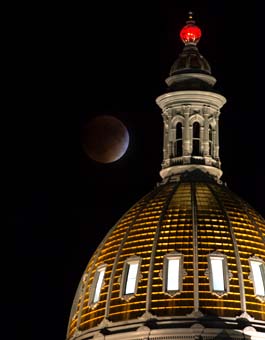
Won't Happen Again for 18 Years
| published September 28, 2015 |
By Thursday Review staff
It hasn’t happened in 33 years, and now it won’t happen again for another 18 years, in 2033. This weekend’s so-called Super Moon, which was a rare convergence of Harvest Moon and a total lunar eclipse. In some parts of the world, the moon was not merely orange—like a typical Harvest Moon—but a dark red or burgundy, sometimes referred to as a Blood Moon.
This striking photo, taken by NASA’s Bill Ingalls, shows the moon on Sunday night as it could be seen in the background behind the Colorado Capital Building in downtown Denver.
The moon’s orbit around our planet is not a perfect circle. A Super Moon occurs when the moon is at its closest position to the Earth, in an orbital position known as perigee—a position which places it roughly 31,000 miles closer to us than when it is at its farthest position. On the evening of September 27, the moon was not merely a full moon, but it was as close to Earth as it would get for all of 2015.
Depending on one’s point on the Earth, and depending on altitude, atmospheric conditions and atmospheric lensing, the moon during this period may appear to be as much as 14% larger. It may also appear some 30% brighter at the moment of perigee. Rare enough, except that this week’s Super Moon also included the Earth’s shadow passing completely across the face of the moon.
The event lasted some one and a quarter hour for millions of people across North America, South America, and much of Europe and North Africa. It was also viewable in some parts of the Pacific and Eastern Asia.
Related Thursday Review articles:
Space Station View of an Aurora; Thursday Review; August 18, 2015.
